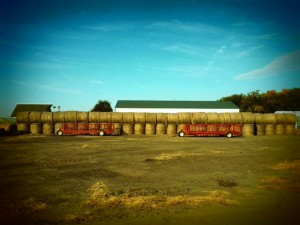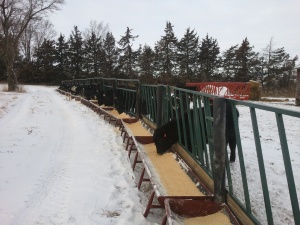So we are getting closer and closer to finally getting the planter hooked up and in the ground. Spring is coming, just not soon enough for most farmers. This mild winter that most of us have had the pleasure of experiencing has gone for enjoyment to boredom very quickly. Every fall a farmer works very had to get harvest completed without battling the winter weather that is always right around the corner. For some farmers, we try to get some Anhydrous Ammonia into the ground before it freezes as well. Anhydrous Ammonia is put in the ground to stock the soil with Nitrogen for the upcoming year. That nitrogen is released into the soil and later used up by the plant over the next year. Not every year allows the farmer to get all this work accomplished before winter snow or a hard freeze locks up the ground. Since everyone was in a rush this year to get their field work done before the snow began to fly, it now leaves us with a lot of dead time with nice days. Even in Nebraska mid 40’s in February with clear sunny skies makes for a really nice day, however, we have nothing left to do. Small odds and ends jobs have been taken care of over the past few months of nice weather. Snow has been cleared from our storm we got February 5th. Now some of us farmers just sit back and watch the snow melt.
What I mean by watching the snow melt is that farmers are sitting at the desk with another hat on. Now they are playing marketer for the upcoming year. There are a lot of numbers that need to be figured in order to make an operation such as farming (large or small) run smooth. The price of corn you hear about on the news is at record highs, so is the Beef markets. Those numbers all sound great on the radio, tv, and magazines, but what isn’t talked about is the price of fertilizer, fuel, seed, and of course we’ve all heard about the price of ground. All this has to be taken into consideration so money will flow right, nobody will get the short end of the stick, and everything will be accounted for. The winter months for a farmer are the biggest planning period of the entire year, its the practice season, just farmers don’t get a practice. Farmers get once chance every year to put a crop in the ground, grow it to the best of their ability, harvest it, and live off of it. So all the time spent in the office crunching numbers, making phone calls, and getting things in line is for a great cause. It wouldn’t be good for a marathon runner to show up the day of the race and start jogging for the first time in 12 months, just like it wouldn’t be good for a farmer to show up in the field in May and start ordering his seed, chemicals, and fertilizers.
With all the above going on right now on our farm too, we also have the added pleasure of raising 250 head of Black Angus Beef Steers. With these cattle, it takes another hat to wear when making these plans. The price of cattle to buy them, what its going to take to raise them (ie; pasture rent, feed, hay, fence materials, shots, etc). Working with cattle gives our farm something extra to do during the winter months and a big something extra to do during the busy field time of the year. It takes a lot out of a person to keep up with livestock over the winter. It’s cold to start with, then you have to make sure your tank heaters are working properly. If a tank heater fails overnight, the next morning you will spend some time with a pick ax breaking open the water for the cattle. If the water freezes that also means that overnight the cattle didn’t have anything to drink and are now very thirsty. When cattle drink a lot, it’s just like people, they get full off what they drank and then they don’t want to eat. If they don’t eat, they don’t grow, and growth is what were going for in the first place. Just to keep this informative, a tank heater (well, our tank heater) is a steel tube that you mount to the inside of the water tank. there is a pilot light, piping, and a thermostat inside this tube. The plumbing then runs out of this tube and is connected to a 1,000 gal propane tank that feeds the heater. When the thermostat senses that the water is cooling off, it opens a valve and the pilot light ignites the gas creating heat just like a household furnace. That keeps the water at a temperature above freezing allowing open water for the cattle to drink out of as needed. The cold weather prevents us from putting a float on the hydrant that would turn on the water and shut it off at certain levels keeping the tank full at all times. So instead we have to fill the tank with a straight hose and monitor it several times a day to keep the tank full of fresh water for the cattle to drink.
Once you have your water situation taken care of for the morning, you can move on to feed. There are 170 steers that are going to be Grass Cattle, or cattle we put out to pasture come spring. We don’t feed them grain very often, maybe twice a month and we do this because we mix in medicine with it so they stay healthy over the cold winter days and nights. The cattle get fed a mix of grass and alfalfa that we had mixed and ground up earlier in the season and stockpiled to feed these calves. We don’t use round bales because these cattle are smaller and aren’t aggressive enough to tear into a round bale on their own so we use this ground up hay and special feeding trailers to feed them. We have 73 head that are on a feed ration and free choice round bale alfalfa hay. The feed is ground up corn with a metabolism additive to keep the animals metabolism up to par over the cold winter when the animals don’t move around as much as they should. The increased metabolism pushes them to eat more as well keeping them warmer and helping them grow leaner, faster, and of better quality. The meat wouldn’t be as good if the animal just laid around all day and didn’t do anything. Meat comes from muscle, and in order to get muscle you have to work out, and since we don’t have a Gold’s Gym for each steer, we use their own metabolism to keep the going with good nutrients and fresh supply of mineral buckets and good hay.
Feed and water are now out of the way, as long as everyone has enough hay, you’re good to go. By this time its about time to go check the water tanks again to make sure they are full. You also have to monitor the lot conditions. with the warmer days we have had, the lot thaws out and makes it mucky for the cattle. With their smaller hooves it sinks in easier and creates pockets and holes everywhere. Once it freezes again, you have a very dangerous area for these cattle to walk on. If something were to startle the animal and they take off running through these deep areas, they could very easily break a leg by getting it cough it the hole. This situation is few and far between, but its still something you have to watch for and if possible, blade down when it thaws out again later in the day. Another thing to watch for is sick cattle. We have done really well the past few years with not having more than 1 or 2 out of the entire bunch. It usually isn’t much more than a cough or bad eye that a quick trip to the vet can’t fix. But if you don’t catch it and let it get away, you could have a very sick animal or worse, lose the animal because of your neglect.
Running a farm over the winter has a lot more work to it than what meets the eye, but that’s what I’m here for, to throw you behind the front page of the farm magazine, to get you the real truth about what goes on from day to day. Sorry its been a while since the last blog but I was working on something worth reading this time. If you have any questions or comments, please feel free to ask. I will gladly answer them to the best of my knowledge as soon as I can.
Have a Great Day!






Great article Chris! Even though I live in cold country I never thought about a water heater for the cattle, thanks for explaining that. When you put the 170 steers in the pasture, do they come to the barn occasionally or stay out there all summer? Also, what is the difference between a farm and a ranch?
Of those that go to pasture, about 30 of them stay at our “home pasture” and those are able to come home as they choose. Barns aren’t used for hardly anything anymore on our farm. We keep what’s left of the small square hay bales in the loft and the bottom part I used to keep cattle in if they get hurt or sick. The difference between farm and ranch varies between everyone. To me a farm has crops and livestock, a ranch is just cattle and grass, and a crop or row crop farm is just crops. But again, that’s just my opinion.
Thank you for the reply Chris, helps me with a goal of mine, learn something new every day. Another question if you don’t mind, what is the difference between plain ole straw and certified straw?